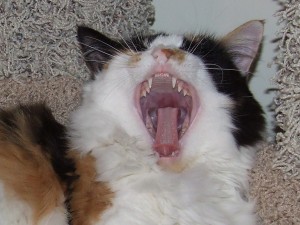Dental Health
Sadly, dental disease is at near-epidemic levels in today’s domestic cat populations. It’s estimated that more than 85% of cats over three years old are suffering from periodontal disease alone, with far reaching health consequences. Dental disease can contribute to other diseases, some of which can be fatal. Toxins and bacteria enter the bloodstream from the mouth and travel throughout the body, stressing the immune system and infecting other organs, especially the heart and kidneys. Teeth rot and cause intense pain that can go unnoticed for months, even years. Around 30% to 40% of healthy adult cats suffer from Feline Tooth Resorptive Lesions (or FORLS), a painful condition that slowly destroys affected teeth, and many others are afflicted with Feline Stomatitis, an autoimmune disorder that causes painful inflammation and sores in the mouth and throat tissues.
 And all this despite the fact roughly 90% of household cats consume mass-manufactured kibble, a product the pet food industry claims has teeth cleaning properties.
And all this despite the fact roughly 90% of household cats consume mass-manufactured kibble, a product the pet food industry claims has teeth cleaning properties.
These claims conflict with the statistics. And, in fact, studies proved decades ago that only one kind of diet promotes and maintains feline oral health. Per Diet Consistencey and Periodontal Disease in Exotic Carnivores (Colyer Institute, 1980):
Much is known about the relationship between dental plaque, nutrition, diet, and oral pathology. What is well known but not well accepted is that:
1. The consistency or texture of food has an affect upon the composition and the rate of dental plaque formation.
2. Soft diets tend to produce more bacterial plaque than firm diets.
3. Excessively course, granular diets can produce periodontal disease through overuse and by direct injury of the supporting tissues.
A 1990 work by the same authors goes on to add:
“Foods of firm consistency will increase the number, distribution, and tone of the capillaries in the gingival tissue; which improves the metabolism and vitality of all of the supporting and sorrounding structures of the oral cavity.”
Only a diet that includes tearing, ripping and scissoring through raw meat, tendons and bones – in other word’s, the cat’s natural diet – provides the necessary stimulation to keep the oral cavity clean and healthy. And the scraping action of the bones, muscle meats and tendons keeps the teeth clean and prevents food buildup, gingivitis and periodontal disease.
A diet that includes whole bone is the single most effective method for preventing dental disease, and can even reverse some damage and restore health to the oral cavity.
The only alternative is brushing the cat’s teeth daily, something most owners find stressful for the cat and *cough* hazardous to their own health.
Influence of Diet Consistency on Periodontal Disease in Captive Carnivores, David A. Fagan, and Mark S. Edwards, Zoological Society of San Diego, Dept. of Veterinarian Services, June 2009.
Also see David A. Fagan, D.D.S., Diet Consistency and Periodontal Disease in Exotic Carnivores, October 1980
(For more information on the benefits of feeding whole bone-in meals to cats, please click here: ‘Dem Bones, ‘Dem Bones, ‘Dem… Scary Bones)
If you enjoyed this article or found it informative, please “Like” it, “Tweet” it, or share it using any of the buttons below. And don’t forget to check out our FB page, join the discussions in our awesome FB group and follow us on Twitter!
Created 02/20/17

